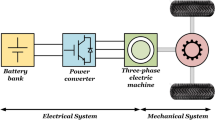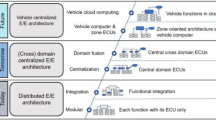Abstract
Eco-driving strategies for vehicles with conventional powertrains have been studied for years and attempt to reduce fuel consumption by optimizing the driving velocity profile. For electric vehicles (EVs) with regenerative braking, the speed profile with the best energy efficiency should be different from conventional vehicles. This paper proposes an energy-oriented cruising control strategy for EVs with a hierarchical structure to realize eco-cruising on highways with varying slopes. The upper layer plans the energy-optimized vehicle velocity, and the lower layer calculates the torque allocation between the front and rear axles. However, the resulting speed profile with varying velocity may cause a high charge and discharge rate of the battery, resulting in rapid battery fading. To extend the battery life, we make a tradeoff between the energy consumption and wear of the battery by formulating an optimal control problem, where driving comfort and travel time are also considered. An indirect optimal control method is implemented to derive the optimal control rule. As an extension, the control rule for avoiding rear-end collisions is presented and simulated for driving in the real world.
Similar content being viewed by others
References
Davis S C, Williams S E, Boundy R G. Transportation Energy Data Book: Edition 34. Energy Convers. Utili, 2015, 176: 319–338
Liu T, Hu X S, Hu W H, et al. A heuristic planning reinforcement learning-based energy management for power-split plug-in hybrid electric vehicles. IEEE Trans Ind Inform, 2019, doi: https://doi.org/10.1109/TII.2019.2903098
Liu T, Yu H L, Guo H Y, et al. Online energy management for multimode plug-in hybrid electric vehicles. IEEE Trans Ind Inform, 2019, 15: 4352–4361
Zhuang W, Zhang X, Ding Y, et al. Comparison of multi-mode hybrid powertrains with multiple planetary gears. Appl Energy, 2016, 178: 624–632
Ilgin Guler S, Menendez M, Meier L. Using connected vehicle technology to improve the efficiency of intersections. Transp Res Part C-Emerging Technol, 2014, 46: 121–131
Zhang F, Xi J, Langari R. Real-time energy management strategy based on velocity forecasts using V2V and V2I communications. IEEE Trans Intell Transp Syst, 2017, 18: 416–430
Hu J, Shao Y, Sun Z, et al. Integrated optimal eco-driving on rolling terrain for hybrid electric vehicle with vehicle-infrastructure communication. Transp Res Part C-Emerging Technol, 2016, 68: 228–244
Jin Q, Wu G, Boriboonsomsin K, et al. Power-based optimal longitudinal control for a connected eco-driving system. IEEE Trans Intell Transp Syst, 2016, 17: 2900–2910
Li S E, Peng H. Strategies to minimize the fuel consumption of passenger cars during car-following scenarios. Proc Institution Mech Engineers Part D-J Automobile Eng, 2012, 226: 419–429
Xu S, Li S E, Zhang X, et al. Fuel-optimal cruising strategy for road vehicles with step-gear mechanical transmission. IEEE Trans Intell Transp Syst, 2015, 16: 3496–3507
Mensing F, Bideaux E, Trigui R, et al. Trajectory optimization for eco-driving taking into account traffic constraints. Transp Res Part D-Transp Environ, 2013, 18: 55–61
Hellström E, Åslund J, Nielsen L. Design of an efficient algorithm for fuel-optimal look-ahead control. Control Eng Practice, 2010, 18: 1318–1327
Doan V D, Fujimoto H, Koseki T, et al. Iterative dynamic programming for optimal control problem with isoperimetric constraint and its application to optimal eco-driving control of electric vehicle. IEEE J Ind Appl, 2018, 7: 80–92
Froberg A, Hellstrom E, Nielsen L. Explicit fuel optimal speed profiles for heavy trucks on a set of topographic road profiles. SAE Technical Paper No, 2006-01-1071
Chen H, Guo L, Ding H, et al. Real-time predictive cruise control for eco-driving taking into account traffic constraints. IEEE Trans Intell Transp, 2018, 20: 2858–2868
Kamal M A S, Mukai M, Murata J, et al. Model predictive control of vehicles on urban roads for improved fuel economy. IEEE Trans Contr Syst Technol, 2013, 21: 831–841
Lin Q, Li S E, Du X, et al. Minimize the fuel consumption of connected vehicles between two red-signalized intersections in urban traffic. IEEE Trans Veh Technol, 2018, 67: 9060–9072
Kohut N, Hedrick K, Borrelli F. Integrating traffic data and model predictive control to improve fuel economy. In: Proceedings of the 12th IFAC Symposium on Control in Transportation Systems. 2009. 155–160
Kamal M A S, Mukai M, Murata J, et al. Ecological vehicle control on roads with up-down slopes. IEEE Trans Veh Technol, 2011, 12: 783–794
Wang M, Daamen W, Hoogendoorn S P, et al. Rolling horizon control framework for driver assistance systems. Part I: Mathematical formulation and non-cooperative systems. Transport Res C-Emer, 2014, 40: 271–289
Xu S, Li S E, Cheng B, et al. Instantaneous feedback control for a fuel-prioritized vehicle cruising system on highways with a varying slope. IEEE Trans Intell Transp, 2017, 18: 1210–1220
Liu T, Wang B, Yang C. Online Markov Chain-based energy management for a hybrid tracked vehicle with speedy Q-learning. Energy, 2018, 160: 544–555
Zhang F, Hu X, Langari R, et al. Energy management strategies of connected HEVs and PHEVs: Recent progress and outlook. Prog Energy Combust Sci, 2019, 73: 235–256
Xu S, Li S E, Peng H, et al. Fuel-saving cruising strategies for parallel HEVs. IEEE Trans Veh Technol, 2016, 65: 4676–4686
Wu X H, He X Z, Yu G Z, et al. Energy-optimal speed control for electric vehicles on signalized arterials. IEEE Trans Intell Transp Syst, 2015, 16: 2786–2796
Xie S, Hu X, Qi S, et al. Model predictive energy management for plug-in hybrid electric vehicles considering optimal battery depth of discharge. Energy, 2019, 173: 667–678
Ramadass P, Haran B, Gomadam P M, et al. Development of first principles capacity fade model for Li-ion cells. J Electrochem Soc, 2004, 151: A196
Spotnitz R. Simulation of capacity fade in lithium-ion batteries. J Power Sources, 2003, 113: 72–80
Fuller T F, Doyle M, Newman J. Simulation and optimization of the dual lithium ion insertion cell. J Electrochem Soc, 1994, 141: 1–10
Wang J, Liu P, Hicks-Garner J, et al. Cycle-life model for graphite-LiFePO4 cells. J Power Sources, 2011, 196: 3942–3948
Bertsekas D P. Dynamic Programming and Optimal Control. Belmont: Athena Scientific, 1995
Li B, Goodarzi A, Khajepour A, et al. An optimal torque distribution control strategy for four-independent wheel drive electric vehicles. Vehicle Syst Dyn, 2015, 53: 1172–1189
Dizqah A M, Lenzo B, Sorniotti A, et al. A fast and parametric torque distribution strategy for four-wheel-drive energy-efficient electric vehicles. IEEE Trans Ind Electron, 2016, 63: 4367–4376
Chen Y, Wang J. Design and experimental evaluations on energy efficient control allocation methods for overactuated electric vehicles: Longitudinal motion case. IEEE/ASME Trans Mechatron, 2014, 19: 538–548
Author information
Authors and Affiliations
Corresponding author
Additional information
This work was supported in part by the National Natural Science Foundation of China (Grant Nos. 51805081, 51575103, and U1664258) and the National Key Research and Development Program in China (Grant Nos. 2016YFB0100906, and 2016YFD0700905).
Rights and permissions
About this article
Cite this article
Zhuang, W., Qu, L., Xu, S. et al. Integrated energy-oriented cruising control of electric vehicle on highway with varying slopes considering battery aging. Sci. China Technol. Sci. 63, 155–165 (2020). https://doi.org/10.1007/s11431-019-9559-2
Received:
Accepted:
Published:
Issue Date:
DOI: https://doi.org/10.1007/s11431-019-9559-2




